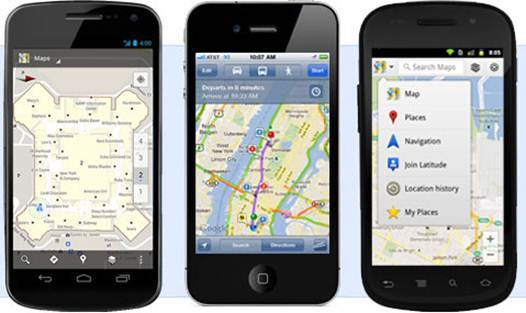Apple has released the latest version of
its mobile operating system, iOS6. It includes over 200 new features, although
not all of these are available on older iOS devices.
As with most Apple updates, it’s free and
available for download over-the-air for all iOS devices.
Maps
Apple’s decision to remove Google Maps from
its mobile operating system and introduce its own mapping service has proved to
be a controversial one, not least because the forced change left many iOS users
effectively missing data.
The Maps app combines information from a
variety of sources: the street data is primarily from TomTom, while business
information is provided by Yelp. Apple has also been buying up mapping
companies over the past few years, including Placebase and Poly9, both of which
specialised in placing information over maps, and C3 Technologies, whose
technology powers the Flyover marquee feature. The latter also specialised in
creating hyper-real maps accurate to within six inches.

Apple’s
decision to remove Google Maps from its mobile operating system and introduce
its own mapping service has proved to be a controversial one
Apple has also been doing all the
cartography itself, rather than using an open-source service such as Open Maps.
In some respects this is a great idea. As you’d expect, Apple has created a
beautiful-looking Map service. And TomTom is respected as a source of reliable
map data, while Yelp has built up an accurate database of information on
businesses. So far so good.
But is it any good? Or more to the point,
is it as good as Google Maps? Let’s start with the marquee feature of Maps,
Flyover. As demonstrated by Scott Forstall attheiOS6 launch, it’s a stunning
new feature that maps photographic detail onto 3D rendered buildings and
objects. While Flyover has the kind of ‘wow’ factor that Apple likes in its
products, it’s limited. Not even the whole of London is available in full 3D
aerial mode. Those areas that are covered are impressive, but we can’t help
thinking that its real world use is limited.
One area where Apple’s Maps outshines the
old Google app is turn-by-turn directions. The lack of directional information
in the old app is thought to be the big bugbear that lead to the partnership’s
end. Apple also felt that Google was keeping back the best features for its
Android Maps app.
The directional information in effect turns
the iPhone into a sat-nay device, and it turns out to be a pretty good one. The
only issue is that the iPhone doesn’t have the entire map cached in memory.
This means it’s reliant on the 3G network and unfortunately this is so
unreliable on UK roads, including the M25, that you’ll probably end up relying
on your trusty sat-nay device.
One thing worthy of note is that the new
Maps app works better offline than Google Maps. In our tests, we found that
Apple’s app stored data to a greater level than Google’s. We tested it in
France and found that road names and details of restaurant, bars and so on was
available without the need to turn on data on our phone. Google Maps was unable
to cache data to this level. We also found that the Maps app uses less data in
general, so if you do need to download mapping information, it won’t cost you
as much.

One
thing worthy of note is that the new Maps app works better offline than Google
Maps.
Maps now integrates with the Yelp app,
giving you access to local business information, and you can also ask Siri to
direct you to locations and perform local searches. For example, you can ask it
to “Find a pub nearby,” and it will bring up a list of local watering holes.
The big problem is that the app is lacking
when it comes to accuracy of the information it offers. From missing train
stations, to misplaced airports and cloud-covered Colchester, the outcry has
been quite understandable. In response to these problems, Apple has asked users
of iOS 6 Maps to report inaccurate data. To do so, you’ll need to click on the
page curl at the bottom right of the Maps screen, then select ‘Report a
Problem’ (the link just above the Drop Pin and Print tabs). Apple says it will
fix the data issues within 48 hours, though in our experience errors remain
some weeks after being reported.
Unfortunately, Google doesn’t appear to be
in a hurry to create a new Maps app for iOS 6. You can, however, get Google
Maps back using the web browser once you’ve upgraded your device’s operating
system. Point it maps.google.com to view the mobile site, then save this as a
web app by clicking the Share button and choosing Add to Home Screen.
The good news is that once you’re past the
new maps, everything else in iOS 6 is a clear improvement.
Safari
Safari’s enhancements are fairly modest,
though there are a couple of additions that bring an extra dimension of
functionality. The Reading List feature Apple introduced in iOS 5 has been
upgraded it now also caches content for offline reading. Publishers can opt not
to make their content available for offline reading, though.
Also new is iCloud Tabs, which lets you
bring up a list of every open tab in Safari on any iOS device or Mac that’s
logged in to your iCloud account. While iCloud Tabs is easily accessible in
Safari on the Mac and iPad, it’s hidden in the iPhone’s browser. You’ll need to
tap the bookmarks icon in the toolbar and find it in the top-level bookmark
list.

Safari’s
enhancements are fairly modest, though there are a couple of additions that
bring an extra dimension of functionality.
Similarly, i0S 6’s Web Inspector is buried
in Settings > Safari > Advanced. Turn this on and connect your iOS device
to your Mac, and you can use the desktop browser’s Web Inspector to tweak
settings on the web page you’re looking at on your iPad a real boon to web
developers.
Safari now has the ability to upload images
to websites. Tap the Upload or Choose File button, and you’ll get the option to
either take a photo or video, or choose an existing image from your photo
library. Of course, rich HTML tools for editing, resizing or cropping pictures
may or may not work correctly.

Safari
now has the ability to upload images to websites.
In the iPhone version, you can now bring up
a full-screen mode in landscape by tapping the double-arrow buttons in the
right hand corner that appear when you tilt the handset sideways. That makes
the content of the browser window take up the full screen the URL bar slides up
out of sight (though you can get it back by swiping down) and the bottom
toolbar disappears, although the back and forward buttons continue to appear,
when relevant, as translucent overlays. To undo the full-screen mode, tap the
arrow buttons again or just turn the phone back to portrait. It’s a pleasant
enough feature, but given the small size of an iPhone’s screen – at least,
pre-iPhone 5 – we’re not sure how much real estate it really buys you.
iPad users get a subtle improvement: Apple
has increased the number of tabs you can have open to 24.